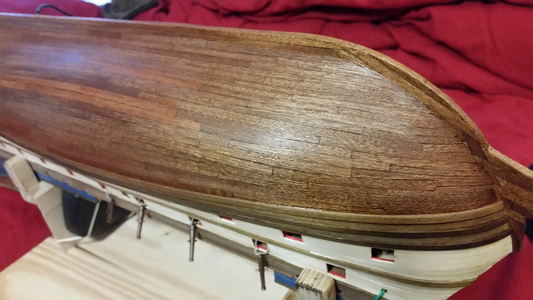Having double planked two 1:64 scale hulls, both from Jotika/Caldrecraft kits I find that their 3mm wide x 0.5 thick planking is quite straight forward for the final planking but I have a few tips.
I always dry fit each plnk and secure with pins against the underside to close the gap on the upper side against the previous plank. I NEVER put the pins through the plank! If the plank needs to be bent and or twisted to wards its end or ends, then the plank to be bent is made wet.
To do this I have a simple device, a piece of pvc drain pipe (for a sink or basin), about 600 mm/24" long with one end plugged/sealed. Stand this vertical and fill with warm water to near the top, then put the planks into the warm water for a good 10 minutes, it will then accept bot bending and twisting to fit.
NOT USE BOiLiNG WATER - IT IS JUST TOO DANGEROUS! Sometime if the job is going well I put 6 planks at a time into the water, and ufit/trim one plak at a time, this saves waiting for a plank to get properly wet through.
I then bend the planks at bow and/or stern and find the best position the make plank lay flat and mate with the previous plank, then mark the width at the end of the plck at the best "lay flat" condition with the planks wanting to overlap, thus the plank will need to be tapered towards the end before final fitting.
Remove the plank and cut the tapered ends if and where required. Then I use Cyano to secure the plank quickly starting from the centre of the hull in each direction, you can pin the plank to butt against the previous plank by pinning against the lower edge of the plank and apply THIN Cyano that will run under the plank and quickly set. Whilst it is setting go to the other end and repeat the pinning and gluing there, then continue at the first end again, and so on until the plank is s fitted over its while length.
The bow end will have to be trimmed to fit neatly against the bowstem, the stern can overlap the stern, by some margin, say 1/2" to 1" or 12mm to 25mm, and then be trimmed off with a razor saw and glass paper when all planking has been completed, and set for a few hours.







